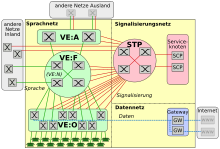Signaling transfer point
A Signaling Transfer Point ( STP ) is a central switching node for signaling traffic .
In the digital telephone networks that are generally used today and in mobile radio networks , voice signals and signaling information are transmitted in different sub-networks. In the subnetwork for voice transmission, switching centers ( fixed network ) or mobile services switching center (cellular network) are the central switching nodes. In the subnetwork for signaling traffic, these are the signaling transfer points.
Position in the signaling network
Signaling networks are usually structured in a star shape, with STPs in the center of the network. The STPs thus have signaling connections to all central network elements of the network and also manage the signaling traffic at network transitions to other networks.
- In the fixed network, the following are mainly connected to STPs:
- Switching centers of the long-distance network (VE: F),
- Network transitions (VE: N, VE: A, STPs of the neighboring networks)
- Network elements with central functions for the entire network, e.g. B. Service Control Points (SCP)
- In cellular networks, the following are connected to STPs:
- all mobile services switching centers (MSC)
- Signaling gateways to other networks
- all Home Location Registers (HLR)
- all Serving GPRS Support Nodes (SGSN)
- Service node, e.g. B. Service Control Points (SCP), Short Message Service Center (SMS-SC)
Logs
Data is exchanged with other network elements on the basis of signaling protocols; the Signaling System 7 protocol is usually used.
With the advent of IP telephony , signaling support via the Internet Protocol is also required. Newer STPs support protocols for SS7-over-IP ( SIGTRAN ) such as M2PA , M3UA and SUA . These protocols replace the lower signaling levels ( MTP and partly SCCP ). The upper levels, such as MAP or CAMEL, remain unaffected.
Protocols for (voice) channel or stream management such as BICC , Megaco , SIP have not yet been actively supported by STPs. The corresponding information is only passed on with the help of SIGTRAN.
tasks
The task of the STP is to analyze and forward signaling messages. For example, the entire call setup and termination is controlled using signaling information. The task of the STP is among other things
- Number evaluation and routing of the signaling messages in the direction of the selected subscriber (forwarding to the destination exchange / destination MSC or gateway)
- Queries in subscriber databases as to which network operator a subscriber belongs to.
- In cellular networks: forwarding of the subscriber data from the HLR to the VLR of the destination MSC
- Forwarding of the signaling messages for switching through or disconnecting voice channels
- Forwarding of service inquiries and inquiries to special numbers (such as 0180, 0800, 0900)
- Global title translation in the SCCP layer so that the signaling messages which are transmitted end-to-end in this layer are routed to the correct point code.
- Signaling gateway functions enable the conversion of SS7 to E1 links to SS7oIP.
- Filter functions make it possible to prevent or reject certain types of signaling messages if necessary.
Almost all functions that are required to use the telephone network or cellular network run over the signaling network and thus over the STPs. A complete STP failure would mean that no one can make calls any more, because then no more phone calls could be started or ended.
Therefore very high demands are placed on the reliability of the STPs. As a rule, STPs are set up in pairs in an active / active configuration. This means that both STPs in a pair are active and each handle half of the incoming messages. The STPs are, however, dimensioned in such a way that one of them could take over all the traffic. If one STP fails, the other can take over the traffic immediately. In this case, the SS7 protocol ensures that no messages are lost.
literature
- Volker Jung, Hans-Jürgen Warnecke (Hrsg.): Handbook for telecommunications. Springer Verlag, Berlin / Heidelberg 1998, ISBN 978-3-642-97703-9 .
- Wolfgang Effelsberg, Hans W. Meuer, Günter Müller (eds.): Communication in distributed systems. Springer Verlag, Berlin / Heidelberg, ISBN 978-3-540-53721-2 .
- Jacek Biala: Cellular and Intelligent Networks. 2nd revised edition, Friedrich Vieweg & Sohn Verlagsgesellschaft mbH, Wiesbaden 1996, ISBN 978-3-322-87271-5 .
See also
Web links
- Signal transmission location (accessed July 13, 2017)
- Introduction to SS7 Signaling (accessed July 13, 2017)
- Signaling Point Code Numbering Plan and Guidelines (accessed July 13, 2017)
- LoadBalancing in Signaling Transfer Points (accessed July 13, 2017)

